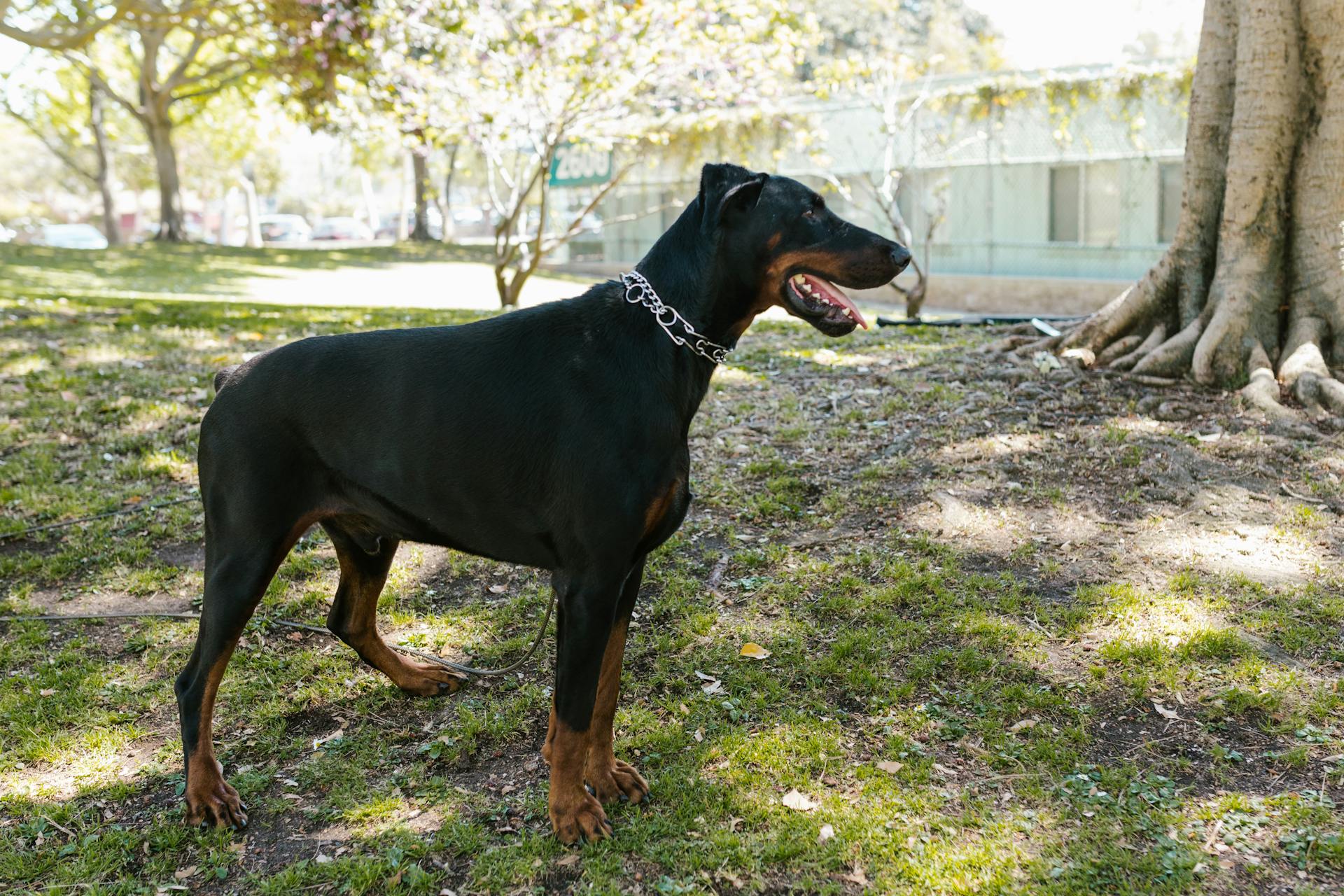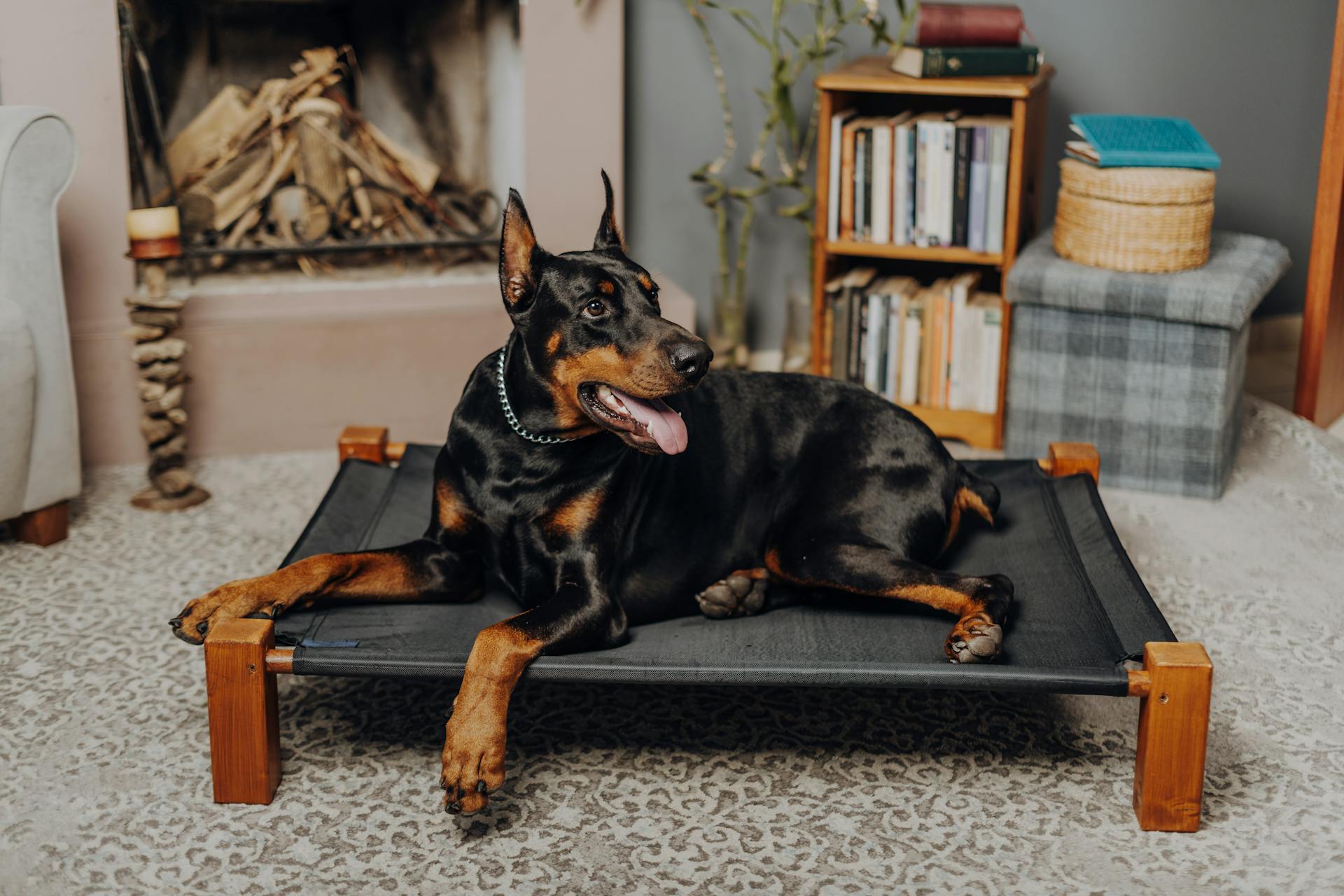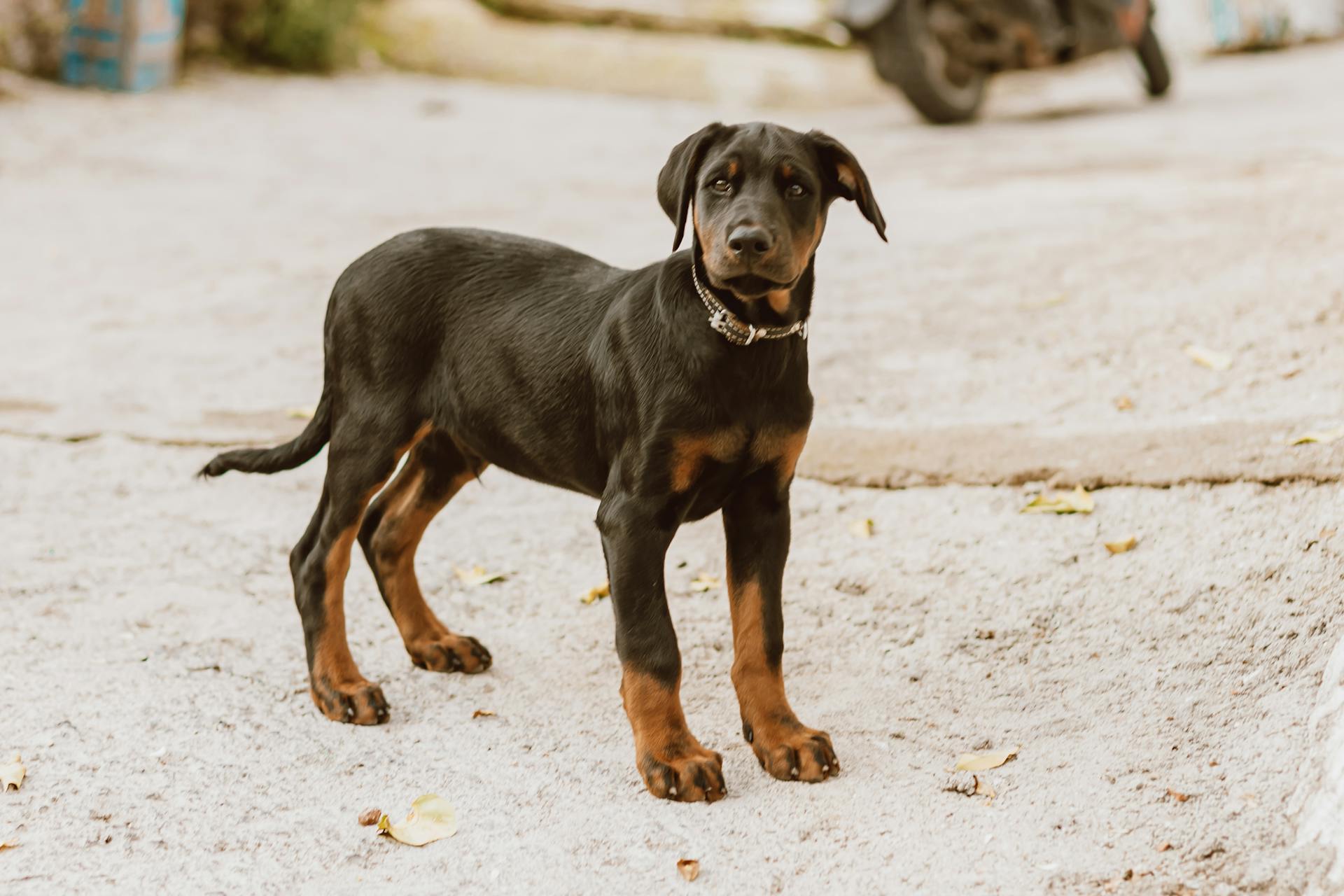
Doberman Pinschers are a breed of dog that originated in Germany in the late 19th century. They were bred as guard dogs and police dogs, and were known for their intelligence and loyalty.
Their distinctive appearance, with a muscular build and a short, smooth coat, has made them a popular breed among dog owners. The Doberman Pinscher's short coat requires minimal grooming, making them a great choice for busy owners.
Doberman Pinschers are highly intelligent and trainable, which makes them excel in obedience and agility training. With proper care and socialization, they can thrive as loving and loyal companions.
Curious to learn more? Check out: Dogs Breeds That Start with B
Doberman Pinscher Care
Dobermans are a low-maintenance breed when it comes to grooming, thanks to their short coat.
Brushing your Dobie a couple of times a week will keep their coat looking shiny and healthy.
A simple bristle brush is all you need to keep their coat clean and free of dandruff.
The KONG ZoomGroom is another great tool for short-coated dogs, removing loose hair and improving coat condition.
Daily teeth brushing is a must to keep your Doberman's teeth clean and healthy.
Your vet should professionally clean your pup's teeth once a year, in addition to daily brushing at home.
Baths are only needed occasionally to keep your dog smelling fresh or whenever they get exceptionally dirty.
Trim your Doberman's nails as needed, usually once a month.
Dobermans love quality time with their people, and grooming sessions are a great way to bond with your dog.
Suggestion: Doberman Pinscher Teeth
Doberman Pinscher Information
Doberman Pinschers have a sleek and muscular appearance, with a proud and powerful presence. They're generally solidly built and compact, with an attentive and observant expression.
Their ears are typically cropped, but this procedure has been banned in many places due to medical and behavioral reasons. You should schedule a consultation with your veterinarian if you're interested in cropping your Doberman's ears.
Doberman's eyes are almond-shaped and mid to dark brown, depending on their coat color. The darker the iris, the better! Their nose is black, brown, gray, or tan, depending on their coat color, and their muzzle is long and narrow.
Here are the different coat colors and lengths of Doberman Pinschers:
- Coat Color: black, blue, fawn (Isabella), or red, with reddish-brown markings.
- Coat Length: smooth and short.
Their tail is often docked, but this procedure has also been banned in many places due to medical and behavioral reasons. If you're interested in docking your Doberman's tail, schedule a consultation with your veterinarian.
You might like: German Shorthaired Pointer Tail Not Docked
Information
A Doberman Pinscher's appearance is sleek and muscular, with a proud and powerful presence. Their ears are typically cropped, but this practice is banned in many countries due to medical and behavioral reasons.
Doberman Pinschers come in a variety of colors, including black, blue, fawn, and red, with reddish-brown markings. Their coats are smooth and short, and their eyes are almond-shaped and mid to dark brown.
Doberman Pinschers are a large breed, standing over 2 feet tall and weighing between 55 to 90 pounds. Males can reach up to 100 pounds, but most Dobies fall within this weight range.
Here are the typical heights and weights for Doberman Pinschers:
Doberman Pinschers are highly intelligent and athletic, making them great guard dogs. They bond deeply with their families and are sometimes referred to as "Velcro dogs."
A Doberman Pinscher's temperament is a mix of loyalty and protectiveness, but with proper training, socialization, and structure, they make loving family members. They are sensitive to correction, so gentle and positive reinforcement is best when training.
Doberman Pinschers are naturally intelligent and learn quickly, but they do require proper training and socialization to become well-mannered members of the home. They are easy to train, but it's essential to use positive reinforcement and avoid correction.
Curious to learn more? Check out: Welsh Corgi Training
Doberman History
The Doberman Pinscher has a rich history that dates back to 19th century Germany, where a tax collector named Louis Dobermann created the breed as a loyal and intimidating companion.
Louis Dobermann wanted a dog that would be strong, intelligent, and loyal, and he achieved this by mixing different breeds such as the English Greyhound, Black and Tan Manchester Terrier, German Shepherd, German Pinscher, Weimaraner, and Rottweiler.
The breed was named after its creator, and by the early 1900s, it had arrived in America, where it was recognized by the American Kennel Club (AKC) in 1908.
Recommended read: Most Loyal Dog Breed
The Doberman's slow population growth in the US was boosted by George Howard Earle III, a Doberman enthusiast and politician, who was also one of the founders of the Doberman Pinscher Club of America (DPCA) in 1921.
Today, the Doberman is a popular family dog and is classified as a Working Group breed by the AKC, which recognizes breeds that have historically performed jobs such as guard dogs and search-and-rescue dogs.
The breed's popularity can be attributed to its excellent skills and qualities, including being a protective and loyal guard dog.
Here's a list of some of the breeds that influenced the development of the Doberman:
- English Greyhound
- Black and Tan Manchester Terrier
- German Shepherd
- German Pinscher
- Weimaraner
- Rottweiler
The Doberman's history is also marked by a random albino mutation gene that occurred in the 1970s, resulting in a new color for the breed (white), but also accompanying health issues.
3 Little-Known Facts About Dobermans
Dobermans are often misunderstood, but here's the thing: they're actually one of the most intelligent breeds around, ranking 5th in Stanley Coren's book "The Intelligence of Dogs".
Their loyalty is unmatched, and they're naturally protective of their families. They make great companions if you're willing to put in the time to train them.
Dobermans are often associated with being aggressive, but the truth is, they're just naturally wary of strangers, thanks to their origins as guard dogs.
Interesting Facts
Did you know that Doberman Pinschers are naturally intelligent dogs, ranking 5th in Stanley Coren's book "The Intelligence of Dogs"? They're known to be one of the smartest breeds out there.
Doberman Pinschers are also known for their athletic ability, with some owners reporting that they can run up to 25 miles per hour. That's almost as fast as a human jogging speed!
These dogs have a short, smooth coat that requires minimal grooming, making them a great choice for busy owners.
For your interest: Are Portuguese Water Dogs Good for First Time Owners
Frequently Asked Questions
Are there 2 types of Dobermans?
Yes, there are two types of Dobermans: the American and European varieties, each with distinct characteristics and purposes. The European Doberman is often preferred for its working ability and roles in search and rescue, military, and police work.
Featured Images: pexels.com


